(Listen to the radio version here.)
A few weeks ago, a day or two after I’d been out of town for a few days, I noticed a dark spot on the dead end road between my house and my neighbor’s—some sort of dead bird. I of course had to take a closer look. Based on the maggots and other grubs, it had been dead for several days, though I'm hardly a forensic entomologist and couldn’t set the time of death more precisely. The tail feathers were stiff and pointed, and the wing feathers I could see were all black, but when I opened them, they had a white patch. This poor thing was a Pileated Woodpecker—the only dead one I’ve ever found.
Right there in the middle of the road, one might guess that it had been killed by a car, but our car never gets quite that far back when we’re backing out of the driveway, and my neighbor goes slowly enough out of his driveway and the short stretch before he gets to Peabody Street that his killing anything would be highly unlikely, too, so although the carcass had been flattened by his or a delivery vehicle at some point, that could not have been the cause of death. And as actual proof of that, the head and neck were completely gone. Directly above the remains was a thick maple limb—the exact spot where I photographed a Great Horned Owl in January 2023.
Owl beaks don’t jut out far from their facial feathers, making them far more reluctant than hawks to stick their faces deep into a carcass. Great Horned Owls often lop off the head on their prey, giving them a nice, clean bite.
This carcass had also been opened up and its pectoral muscles ripped out. Owls may be fastidious but they’re not wasteful, so a Great Horned Owl may have done this, or the neighborhood fox or a crow. I'll never know.
Without the head and with the innards flattened, there was no way to determine whether this bird was a male or female. I did know for certain that it wasn’t BB—since getting home from our trip, I’d already seen him a few times, and even if I hadn’t, the feet and legs were intact with no USFWS band. But who was it?
It’s possible it was BB’s mate. After the two of them appeared together once or twice in late winter/early spring, I haven’t seen a female more than once or twice, but then again, I never saw his mate last year after nesting began.
Male Pileateds do more than half the work of incubating eggs, trading off fairly evenly during daylight hours and doing all the incubating every night. And males share pretty evenly the care and feeding of nestlings and fledglings—the males may even do slightly more than the females. In woodpeckers as with many species, pairs are far more successful than single parents at keeping their young alive and thriving.
Based on the direction BB always heads after visiting my yard, I suspect he’s nesting somewhere south of here but don’t know where, and so have no way of checking to see whether his mate is still present. This past weekend, I tracked him when he left my yard to a telephone pole in the alley behind the house across the street, and from there to another pole to the west, and then to a third. Twice he yelled out, his head facing southwest. I suspect, or at least hope, that he was giving his mate an update about when to expect him home.
Besides BB’s mate, there’s one other individual Pileated Woodpecker I hope the dead one isn’t—that is whichever of BB’s sons spent at least a couple of hours in my yard last September 9.
He was still sort of hanging out with his dad but was more independent than his brother. So BB spent time feeding one son while the other explored the back of my yard on his own. That one allowed me to hang around photographing him at very close range while he checked out the stump Russ set up for me to sit on to take pictures …
… then a few of the decayed logs surrounding our raspberry patch …
… and then one of our birdbaths.
His brother and BB flew off pretty quickly, but after this guy was done checking everything out, which took an hour, he took a nice long nap up in our ash tree, at a bad angle for me to get a photo, but that was okay. I let him sleep. He woke up when BB returned with his brother, and after trying to figure out the feeder on his own and begging for a meal from his dad, the three of them flew off.
I got hundreds of photos of this guy, but there is no way I could ever recognize him again with any certainty.
Wednesday, I noticed that my suet feeder was out of "Super Suet," the kind BB clearly prefers. When I went out (without my camera), a male Pileated without a band was in the box elder in the back of my yard. When I walked to the feeder, he flew much closer, to the box elder between my house and the feeder, and watched as I put the Super Suet in the suet cage. Then, before I’d walked even a few feet away from the feeder, in he flew. He may or may not be one of BB’s sons, and may or may not be the one who let me come so very close last fall—I’ll never know.
It’s both wonderful and heartbreaking that without a leg band or a permanent unique physical feature, we can virtually never be 100 percent certain about any individual bird's identity, from day to day much less year to year. I’m very sad that one of my neighborhood Pileated Woodpeckers got killed by a predator, but I feel guilty that I was so relieved that it couldn’t be BB and so hopeful that it might not have been his mate or that one son.
Every Pileated Woodpecker has a right to thrive on this little planet and in this tiny neighborhood, even as every Great Horned Owl has a right to look at each one of them as a potential meal. It may not be fair of me to play favorites, but it’s very human.


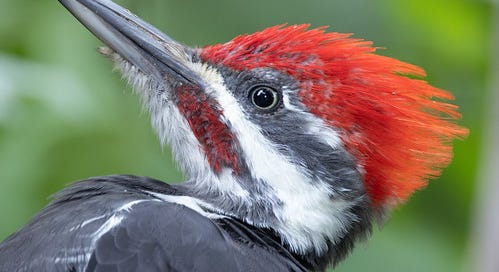



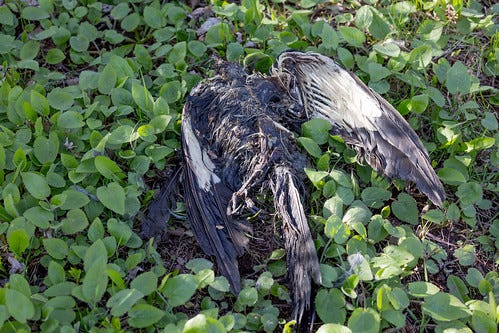
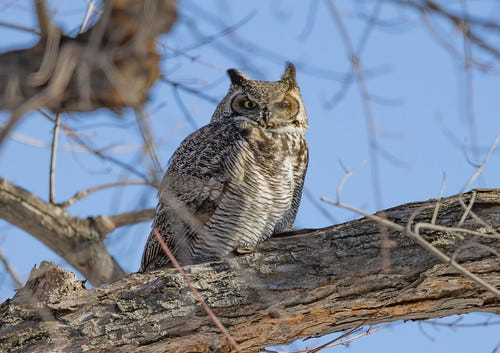
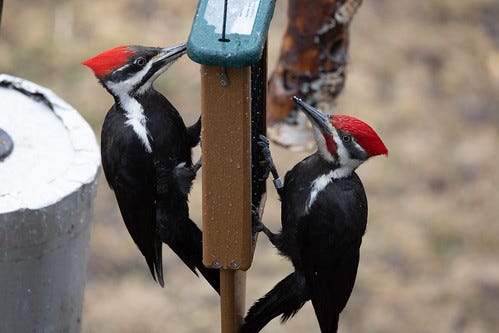
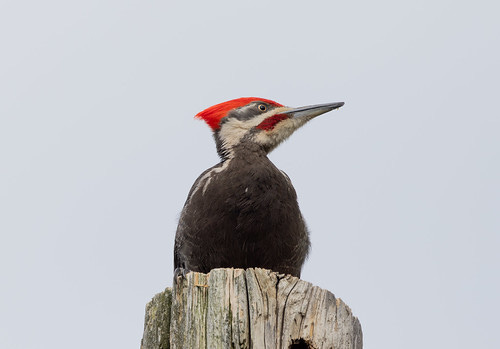

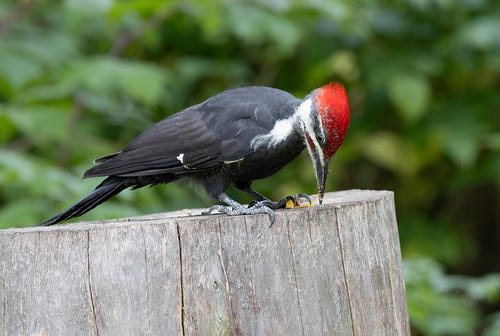
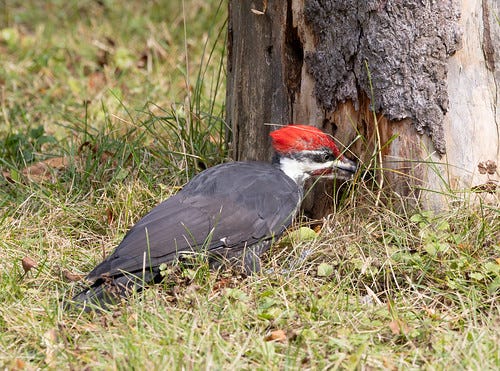
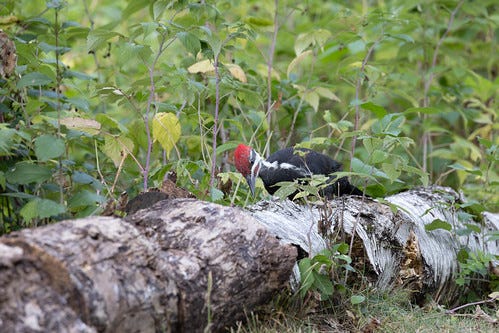
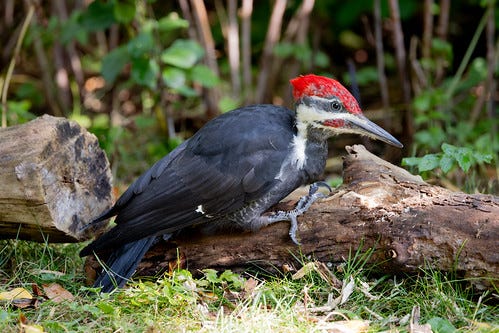
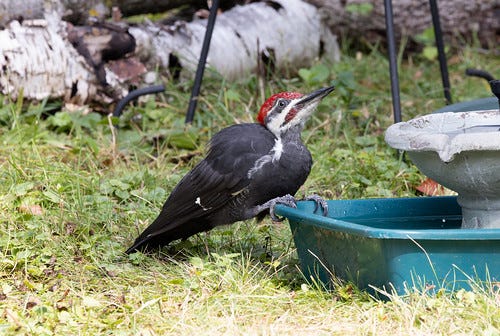
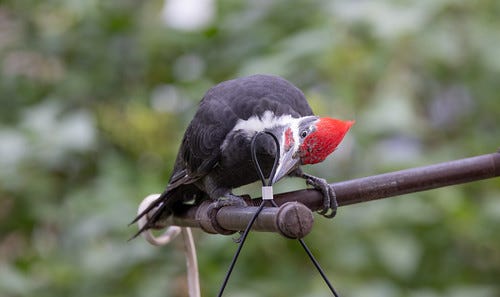
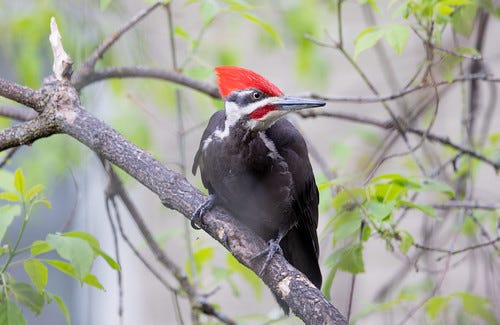
Pre-pandemic, I joined a committee with STL Audubon Society to do bird mortality surveys in downtown St. Louis. As heartbreaking as it was finding birds that had been killed by window strikes, we started finding birds without heads around the Thomas Eagleton Federal Courthouse. When security asked what we were doing, we explained our survey. Security staff then told of a nesting Peregrine Falcon on the 22nd floor, outside a library window. This of course explained the headless corpses. I believe that World Bird Sanctuary was allowed into the courthouse to observe the nesting falcons, but could not band chicks. The windows were sealed.
So glad you live where you do and give us eager minds new knowledge about the birds you see and connect with in your backyard "friends"! Wish you could have recognized the pileated you found but I'm with you (human) and glad it wasn't BB ...